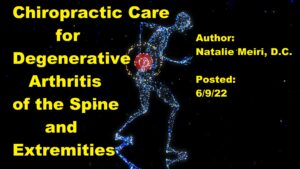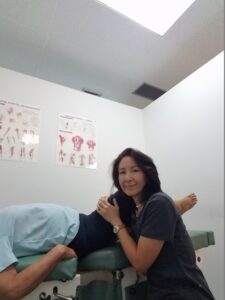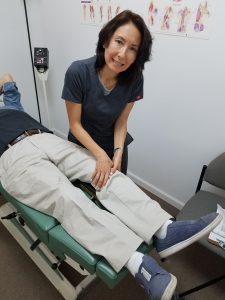
Arthritis has a “geriatric” connotation, yet it may affect any age group. The term simply means that the joint is affected (joint disease/disorder). Arthritis can be due to many causes such as degeneration or destruction that is age-related or trauma related, infectious, inflammatory, and/or autoimmune. This post is about Chiropractic Care for Degenerative Arthritis of the Spine and Extremities (arms and legs).
Degenerative arthritis or degenerative joint disease is also referred to as osteoarthritis. This serious, painful condition can affect any joint of the body (e.g. hands, knees, hips, shoulders, back and neck). It is by far the most common form of arthritis, affecting more than 32.5 million adults in the United States, according to the Centers for Disease Control and Prevention.
Firstly, osteoarthritis is a disease of the entire joint, including bone, cartilage, ligaments, menisci (e.g. knee meniscus) and the tissues lining the joint (the synovium). There can also be changes in periarticular (around the joint) muscles, nerves, bursa, and local fat pads that may contribute to the symptoms of osteoarthritis. Secondly, it is referred to as a “wear and tear” arthritis because it degrades cartilage, changes bone shape and this causes inflammation. Thirdly, the result is pain, stiffness and loss of mobility. Lastly, pain and other symptoms of osteoarthritis may lead you to feel tired, have problems sleeping, and feel depressed.
Different Types of Osteoarthritis
-
Primary Osteoarthritis
Primary Osteoarthritis occurs usually in middle-aged to elderly people (>45 years old). It is more prevalent in women (female to male 10:1). Primary means this osteoarthritis develops due to aging and the wear and tear that comes along with it.
An example would be primary femoroacetabular (hip) osteoarthritis. Typically, your symptoms consists of hip and possibly buttock, groin, or knee pain that was insidious (came on gradually) in onset. Additionally, you note a slow stiffening, specifically internal (inward) rotation. This often results in walking with the hip held in external (outward) rotation. You may complain of low back pain due to excessive extension with weight bearing. The low back pain is really due to compensating for limited hip movement due to hip osteoarthritis.
Common joints involved in primary osteoarthritis are the hips, knees, sacroiliac joint, acromioclavicular (shoulder and collar bone), first metacarpophalangeal (part of thumb joint), first metacarpotrapezium (part of thumb joint closer to wrist), and the distal interphalangeal joints (joints at tips of fingers).
Often initially asymptomatic, you will have a gradual increase in joint stiffness and pain. Moreover, deformity may be apparent such as herberden’s nodes in the hands (bony bumps). If not treated, primary osteoarthritis may eventually lead to joint subluxation (dislocation) and instability.
Cause
Primary osteoarthritis is due to progressive degeneration of the joint or joints involved by an accumulation of microtrauma. A microtrauma is an injury resulting from repetitive stress to tissues.

-
Secondary Osteoarthritis
Starting as young as the twenties, secondary osteoarthritis can occur at a younger age than primary osteoarthritis (>25 years old). It occurs equally in both men and women. Common joints involved are the glenohumeral (shoulder), acromioclavicular (shoulderblade and collarbone), sacroiliac ( sacrum and iliac links spine and pelvis), hip, elbow, knee, foot, and hand. Secondary osteoarthritis is similar to primary osteoarthritis in signs and symptoms. However, there may be a history of trauma to the joint(s) such as an accident or fall, or you may have other joint diseases. For example for the hip, you could have crystal deposition disease (i.e., gout).
Cause
Secondary osteoarthritis is due to other disorders or diseases/ injuries. These primary causes could be trauma, septic or inflammatory arthritis, slipped epiphyses (near growth plates of long bones in kids), dysplasias (rare genetic disorders in kids), fracture/dislocation, avascular necrosis (death of bone tissue due to a lack of blood supply), and acromegaly (disorder in adults in which the pituitary gland produces too much growth hormone).
-
Erosive Osteoarthritis
Erosive osteoarthritis affects predominantly women (40-50 year olds). The only joints involved are the interphalangeal joints of the hand. Each finger on your hand, with the exception of the thumb, has three phalanges (bones that make up the fingers) separated by two joints known as interphalangeal joints. Basically, erosive osteoarthritis is interphalangeal joint arthritis or arthritis of the fingers.
Erosive osteoarthritis is an Inflammatory variant of degenerative arthritis. It is characterized by cartilage degeneration and synovial proliferation (joint lining gets inflamed). While pain is common in osteoarthritis, obvious inflammation (redness and swelling) is not. Osteoarthritis has traditionally been classified as a noninflammatory arthritis because obvious inflammation (redness and swelling) is considered a symptom of other types of arthritis. However, erosive osteoarthritis does have redness and swelling which makes it a variant.
Acute episodes that appear similar to inflammatory/synovial arthritis (e.g. rheumatoid arthritis) happens. Chronically, erosive osteoarthritis may evolve to subluxation (joint dislocation) and development of herberden’s nodes. On x-ray, the findings are similar to the noninflammatory (primary or secondary) osteoarthritis with additional findings of central erosions (bone erosions seen on ray).
4. Degenerative Spine Disease
Degenerative Spine Disease (Osteoarthritis of the spine) presents equally among both men and women (>30 year olds). Common spinal joint levels involved are cervical (neck) levels C5-C7, thoracic (midback) levels T2-T5, T10-T12, lumbosacral (lowback) levels L4-S1. Your pain and stiffness may range from mild to severely symptomatic. Osteoarthritis of the spine may contribute to intervertebral foramen (opening where nerve roots exit the spine between every two vertebrae) narrowing resulting in spinal stenosis. This puts pressure on the nerves that travel through the spine.
Chiropractic Care of Degenerative Arthritis of the Spine and Extremities at Meiri Chiropractic:
General program includes Chiropractic Manipulative Therapy to the spine and extremity (arms and legs) joints for 2-3 months. Then “maintenance of normal joint motion and function of the spine and extremities may be facilitated by adjusting/manipulation” (1).
Additionally, manipulation of muscle contractures with soft tissue techniques may be accomplished with gentle PNF/PIR (e.g. post isometric relaxation) and/or myofascial release techniques. Next, therapeutic exercises for strengthening of the joint will help for active care at home. Finally, recommendations on anti-inflammatory diet will be of benefit for patients.
Research on How Chiropractic Adjustments Can Help With Arthritis
A 2017 review in the Journal of the American Medical Association, found that spinal manipulation reduces lower back pain. And a 2013 study published in Osteoarthritis and Cartilage found that patient education combined with 12 chiropractic treatments (twice a week for six weeks) were more effective for hip Osteoarthritis than a daily stretching program or patient education alone.
Getting regular chiropractic treatment at a West Palm Beach chiropractic center can help naturally relieve the pain and dysfunction of degenerative arthritis of the spine and extremities. Chiropractic is a holistic and natural way to not only treat existing conditions, but to keep your body in its best working condition.
Contact Meiri Chiropractic today at 561-253-8984 on Chiropractic Care of Degenerative Arthritis of the Spine and Extremities or/and other ailments.
References:
(1) Thomas Bergman, David Peterson, Chiropractic Technique Principles and Procedures, 3rd edition, 2011
Meiri Chiropractic
561-253-8984
